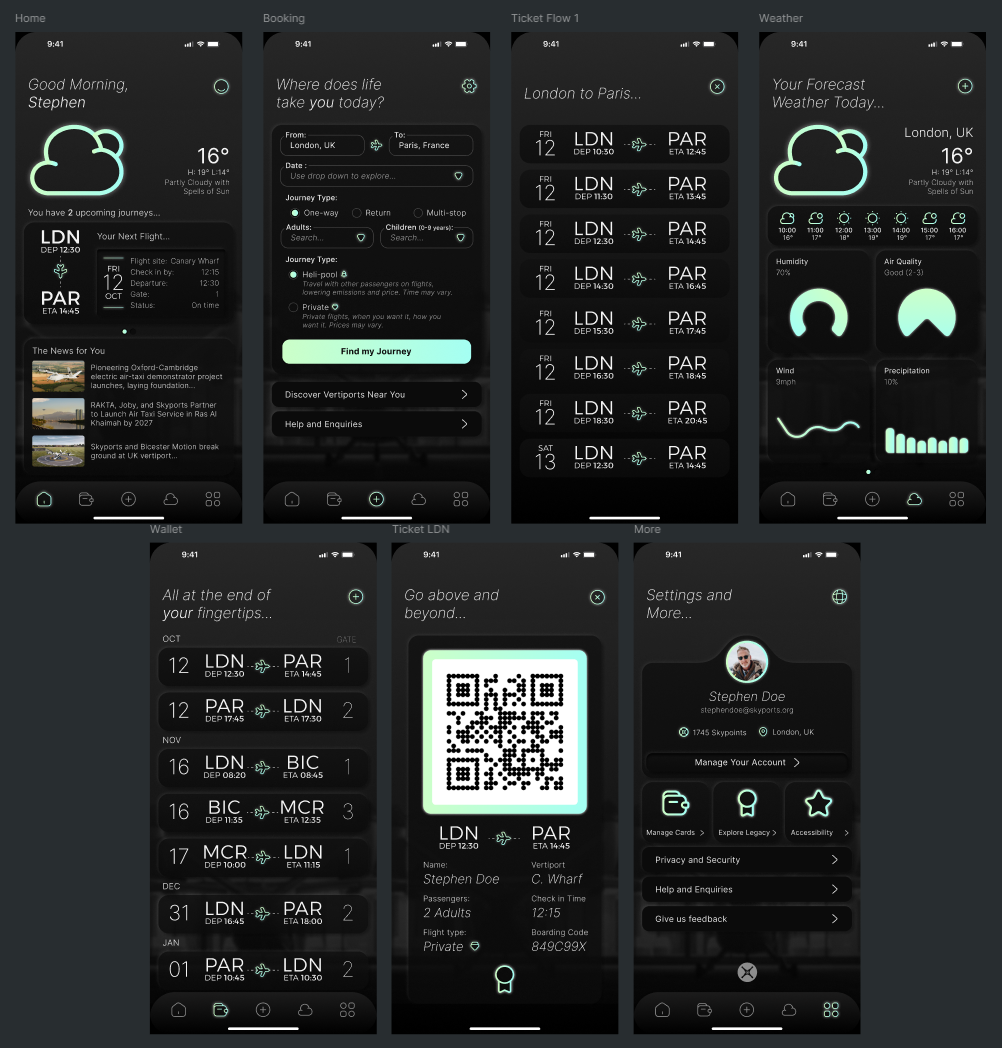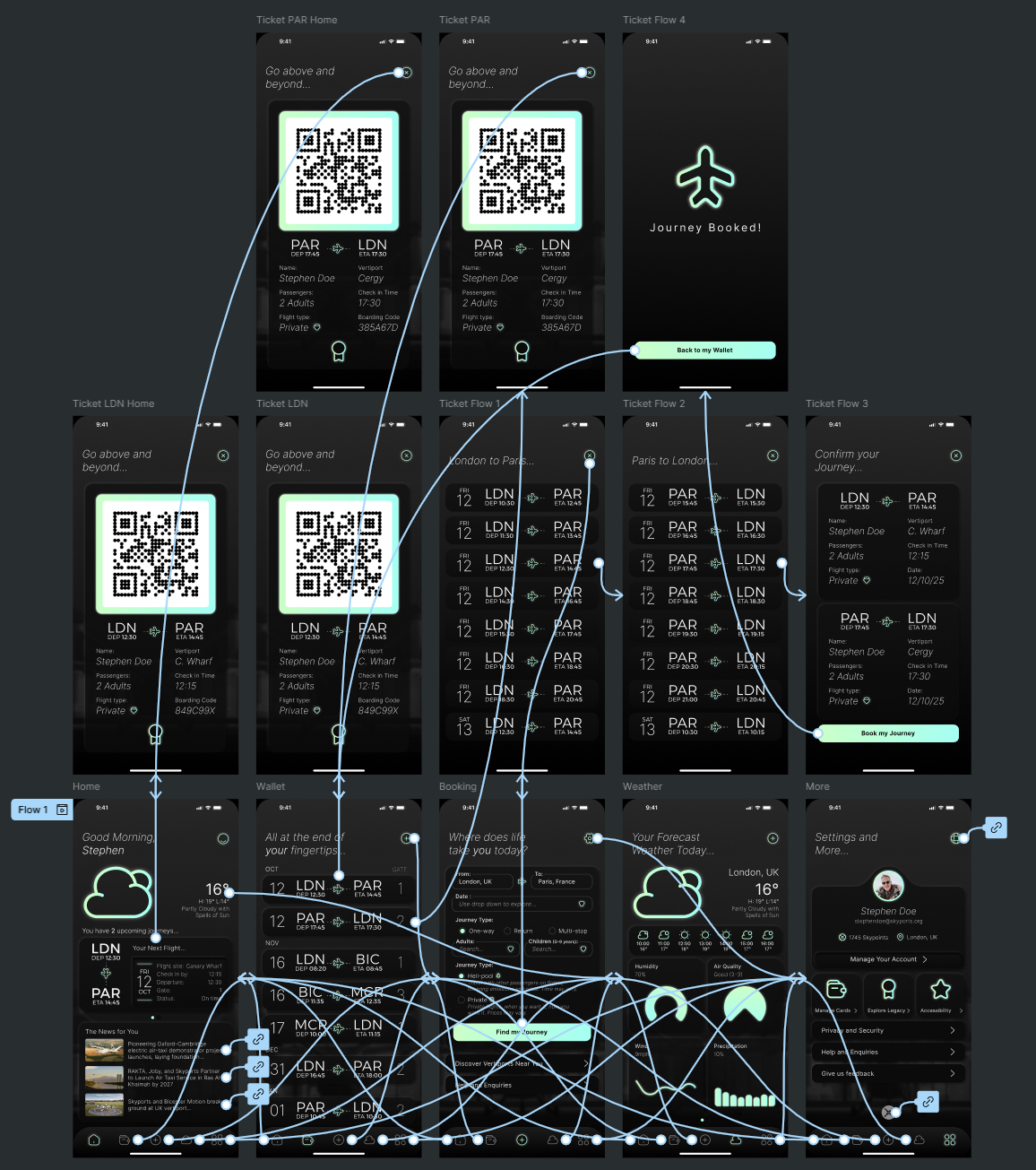
From Ground to cloud.
Skyports and the Future of Urban Transport
Project Role: End-to-end designer: responsible for research, ideation, prototyping, UI design, usability testing, and implementation
Time Scope: One Month
Urban travelers face challenges in easily booking and managing drone transportation due to the lack of a user-friendly app that provides clear scheduling, route information, and seamless booking experience
This case study presents a conceptual design for a drone booking system for Skyports, a prominent operator of drone delivery and inspection services. It is important to note that this project is an independent initiative and I have no affiliation with Skyports. This case study was undertaken solely for portfolio purposes to explore user experience and interface design within the innovative and growing field of drone logistics.
Project Overview
The Client
Skyports is a London-based leader in Advanced Air Mobility (AAM) infrastructure, designing and operating vertiports for electric aircraft and providing drone services worldwide. The company’s partnership with Dubai’s transport authority and Joby Aviation will launch the first commercial air taxi service in Dubai by 2026, reducing car journeys from 45 minutes to just 10 minutes by air. Skyports operates across the UK, Singapore, Dubai, Colombia, and the US, supporting seamless, sustainable urban transport through innovative technology and passenger-focused design.
The Probelm Statement
As the world’s first commercial Advanced Air Mobility service launches in 2026, urban travelers lack a digital platform to easily plan, book, and manage air taxi journeys. Existing apps don’t meet the needs of this new transport mode, which requires features like vertiport mapping, flexible scheduling for weather disruptions, and unique ticketing options. Without a purpose-built solution, uncertainty and barriers to adoption persist. A seamless, user-friendly app is needed to support confident, efficient use of air taxis.
Success Metrics
Achieve widespread user adoption of the new AAM service.
Provide a seamless, confident booking experience that accelerates AAM uptake.
Ensure operational efficiency and reliability in journey planning and ticketing.
Deliver high user satisfaction and trust in the app.
KPIs
Daily and monthly active users.
Booking completion rate (% of started bookings completed).
Net Promoter Score (NPS) and average user rating.
Task success rate (users booking journeys without errors or assistance).
Target Audience
Affluent urban professionals and executives who value significant time savings and convenience over cost.
Business travelers frequently moving between city centers and airports or multiple city locations.
High-income tourists seeking unique, premium transport experiences.
Tech-savvy early adopters willing to pay a premium for innovative, sustainable travel.
research and discovery
Competitor Research Analysis
Below is a concise analysis of key competitors in the premium urban air mobility space, focusing on their core user segments, geographic presence, and distinctive user experience features.
| Competitor | Target Market | Geographic Focus | User Experience | App |
|---|---|---|---|---|
| BLADE Air Mobility | Urban professionals with £250,000+ household income, high-net-worth individuals, corporate travelers | New York, Los Angeles, San Francisco, Miami, Vancouver, Southern Europe | Mobile app with high digital transaction completion rate, fast booking times, real-time flight tracking, dynamic pricing | Yes |
| FindHeli | Business and leisure travelers seeking helicopter flights globally | Global, with strong presence in European markets | Hotel-style booking interface, 24-hour operator proposals, multi-language support, Progressive Web App | Yes |
| GetHeli | High-net-worth individuals, corporate clients, event transportation users | UK and Europe, strong London operations, partner of London Heliport | Instant pricing calculator, 24/7 live chat support, shared-flight “heli-pooling,” same-day booking dashboard | No |
-
Blade Air Mobility Inc: Business Model Canvas and SWOT Analysis (digitaltravelconnectus.wbresearch.com)
How BLADE Is Combining Image and Aviation to Make Flying Stylish (digitaltravelconnectus.wbresearch.com)
Case Study: FindHeli (cheesecakelabs.com)
FindHeli Travel Platform (findheli.com)
Get Heli Pricing Calculator (getheli.com/pricingcalculator)
Get Heli launches 'heli-pooling' shuttle system (revolution.aero)
Key Points and Takeaways
Blade and FindHeli offer dedicated mobile apps with real-time updates and premium booking features, appealing to affluent, time-sensitive users.
Skyports should prioritize creating a polished mobile app with seamless real-time information and a smooth booking experience to meet user expectations and compete effectively.GetHeli uses a web platform without a mobile app, which may limit accessibility for on-the-go users.
Skyports’ UX should emphasize mobile-first design for ease of access anywhere, ensuring users can plan and book journeys effortlessly on their smartphones.Blade has strong presence in the US and Southern Europe with scalable, enterprise partnerships.
Skyports can focus on building scalable solutions and partnerships to support growth while maintaining consistent user experience across regions.FindHeli’s global reach and hotel-style interface support wide adoption, especially in Europe.
Adopting familiar interface patterns and clear, simple booking flows can encourage user trust and higher adoption rates for Skyports.GetHeli’s heli-pooling and transparent pricing provide cost benefits but lack a mobile app for full premium experience.
Integrating transparent pricing and innovative features like shared rides within the Skyports app can enhance user value while maintaining a premium feel.
User Personas
Analytics and Secondary Data Review
Urban Air Mobility Market Growth
The global Advanced Air Mobility market is projected to grow from USD 5.56 billion in 2025 to USD 14.68 billion by 2029.
This represents a compound annual growth rate (CAGR) of 27.5%.
The rapid expansion is driven by strong investment, infrastructure development, and increasing public acceptance of aerial ride-sharing services.
Travel App Engagement and Adoption
Global travel app downloads reached 4.2 billion in 2024, a 3% increase year-over-year, with time spent in travel apps surpassing 20 billion hours (up 7.3% YoY).
39% of users prefer mobile apps over websites for speed, and 33% rely on airline apps for real-time trip information.
These figures highlight mobile apps as the dominant channel for journey planning and booking.
Helicopter Charter Market Dynamics
The helicopter charter market was valued at USD 8.1 billion in 2024.
It is expected to reach USD 15.9 billion by 2033.
The market is projected to grow at an 8.0% CAGR from 2026 to 2033.
Growth is driven by rising demand for on-demand, time-sensitive transportation in urban and offshore sectors.
-
Urban Air Mobility Market Report 2025 (https://www.researchandmarkets.com/reports/5766791/urban-air-mobility-market-report)
2025 State of Mobile Travel Apps (https://sensortower.com/blog/2025-state-of-mobile-travel-apps)
70+ Online Travel Booking Statistics and Trends (https://www.travelperk.com/uk/blog/online-travel-booking-statistics/)
Helicopter Charter Market Size, Market Trends, SWOT & Growth Forecast (https://www.verifiedmarketreports.com/product/helicopter-charter-market/)
Implications for Skyports UX & Strategy
Prioritize a mobile-first app with performant, responsive design, as users overwhelmingly favor apps for speed and convenience.
Integrate real-time data (e.g., flight status, weather) to match expectations set by travel and aviation apps.
Leverage the high growth trajectory of the AAM sector by designing scalable features that can evolve with market expansion.
Offer transparent pricing and innovative options (e.g., pooled rides) to capture market share in the burgeoning helicopter charter segment.
Identified User Pain Points
Complex Booking Processes:
Users dislike lengthy or confusing booking flows. Interfaces must be intuitive, minimizing steps while providing clear options for route, pricing, and timing, as modeled by FindHeli’s hotel-style booking.
Perceived Safety and Trust:
Newness of AAM and associated safety, security, and environmental concerns affect user confidence. Clear communication and design focused on safety features are vital to gain public acceptance.
Lack of Real-Time Information:
Flight status, weather, and operational updates are critical to building user trust and convenience. Delay or absence of real-time data creates uncertainty and dissatisfaction.
Process and design
User Flow Diagram
This user flow diagram outlines the main steps users take to complete core tasks in the app, providing a clear overview of navigation and decision points for a streamlined experience.
Final Visual
This high fidelity wireframe fully reflects the official app’s visual style, branding, and layout. As the final stage before building an interactive prototype, it presents every key screen and component with production-ready detail, ensuring all design decisions are clearly represented before moving forward.
Lo-fi ‘Paper’ Wireframe
This low fidelity wireframe presents multiple variations of each core page, serving as a brainstorming tool to explore different layouts and navigation options. It helps quickly visualize and compare structural ideas before moving to detailed design.
Final Wireframe
The final wireframe represents the complete structure and layout of the design before visual styling and development begin.
solution and final prototype
Final Prototype
This interactive prototype illustrates the core user flows and key features of the booking app, providing a hands-on preview of the user experience. It is designed to showcase how users can easily navigate through the booking process, from searching to confirming a reservation. Ins before moving into full development. ons before moving into full development. It highlights the app’s focus on simplicity, efficiency, and a smooth, intuitive experience tailored to our target users.


